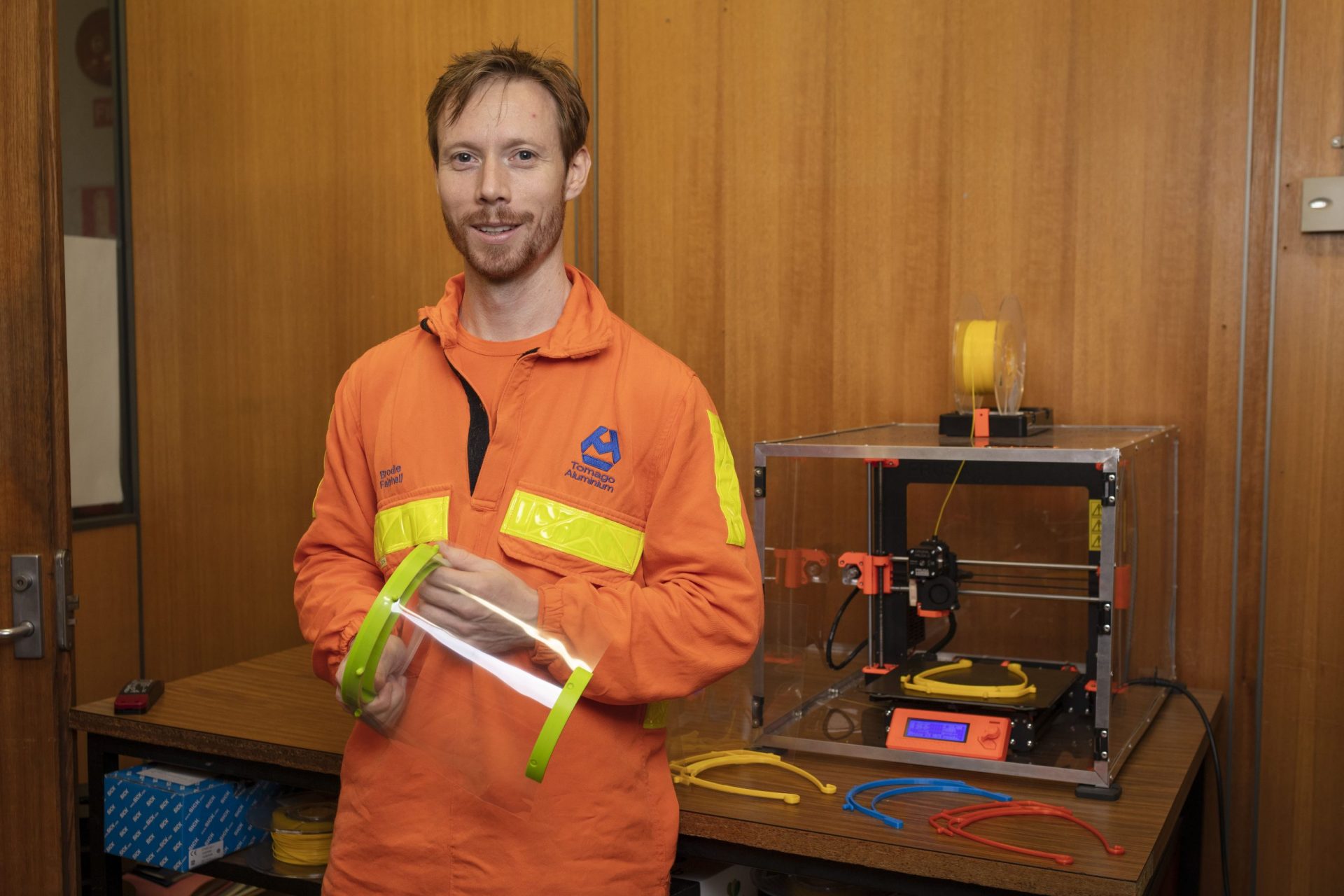
When COVID-19 declared war on the world and forced us into lockdown some chose to stand and fight the pandemic in any way they could. Tomago’s Brodie Fairhall was one of them.
If, at the start of this year, anyone had asked Tomago Innovation Engineer Brodie Fairhall about his 2020 plans, it’s doubtful ‘developing a community-based manufacturing industry and helping fight a global pandemic killing thousands’ would have been on his list.
That was then, this is now and six months into the crisis Brodie has started getting some normality back into his life after creating an alliance of 3D printer owners, both individual and corporate, to make medical-grade face shields for use on the COVID-19 front line, in hospitals and by other sections of the medical industry.
Working from home once COVID-19 restrictions were introduced, Brodie anticipated that the shortage of Personal Protection Equipment facing hospitals in Europe and the United States would become a problem for Australia.
No stranger to 3D printing, he turned his skills to not only designing and making protective face shields for health workers but also devised a plan to have them made in large quantities and distributed to those who needed them.
Rightly, Brodie reasoned that making shields the usual way would take eight weeks or more just to get started while 3D printing was immediate, perfect for the COVID crisis.
He contacted his manager, Mal Muddle, and asked if Tomago could supply the plastic products he needed to manufacture his prototypes, a request with which the company was only too happy to assist.
Knowing that one 3D printer was limited in its output, Brodie started tracking down and contacting 3D printer owners in Australia and New Zealand, everyone from individuals with 3D printers at home through to large companies with hundreds of printers, or printer ‘farms’, bringing them onboard and up to speed with the manufacturing processes involved.
“Initially I got stonewalled at every turn because so many people were trying to do the same thing,” Brodie recalled. “I thought it made sense to form into a co-operative so we became the Open Manufacturing Alliance which now has 308 members who, combined, could produce 50,000 face shields in a few weeks.”
As that was happening he was dealing with doctors, hospitals, state and federal politicians and a range of public servants across a number of levels in an effort to determine the best way to manage the acceptance and distribution problems, hastening the red tape cut-throughs necessary to have the shields accepted for widespread use.
For several weeks Brodie worked a punishing schedule, performing his regular Tomago tasks on his rostered work hours, switching to the manufacturing alliance between 4pm and midnight, grabbing a few hours’ sleep then starting all over again when his alarm went off at 6am.
Sleep, he reasoned, was overrated. Weekends? They were for other people – he had to deal with things like design and manufacture, quality control, product approval, certification and use; problems and issues needing solutions yesterday.
“There were hoops to jump through and I was getting conflicting information. Frontline medical workers were telling us they needed equipment, some procurement officers were telling a different story,” he said.
And when they were ready to be distributed, hospitals were unsure if they were allowed to use equipment sent by individual suppliers.
“That problem was sorted when some large medical companies became involved and were able to get Therapeutic Goods Administration approval for a design that alliance members were producing.
“Once we had TGA approval and could get the product out, there was suddenly demand,” Brodie said.
At that point his role changed from manufacturer to administrator, stepping outside his area of expertise to manage the alliance’s huge team of volunteers, a major challenge that took him out of his personal comfort zone.
Brodie is now keen to progress work with Newcastle-based Sparkhaus, a maker’s co-operative managed by health professionals who are themselves working on creating intensive care ventilators, using 3D printing to make some of the parts.
Reflectively, he says the COVID-19 outbreak should prove to governments and businesses alike that democratised manufacturing is a reality.
“It’s obvious the manufacturing sector is capable of responding quickly and that should help in future crisis situations, where people will not only be able to learn from this experience but understand and accept that it is possible to team up, innovate and manufacture products locally.”
“We’re currently exploring ideas of sending product to places like Indonesia and the United States and we’ve been looking at other areas, other types of product. It will be demand-driven. There is scope for post-COVID-19 manufacturing and it’s not just 3D.”
Brodie Fairhall’s Open Manufacturing Alliance could even stand as an introductory model for restarting widespread Australian manufacturing in a post-COVID world.

